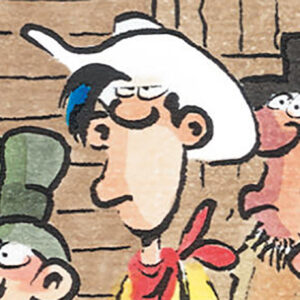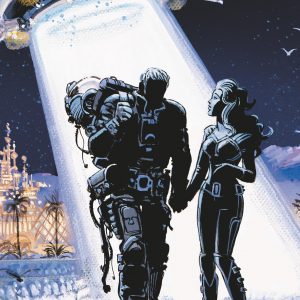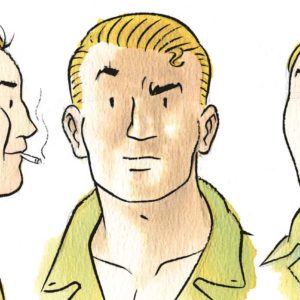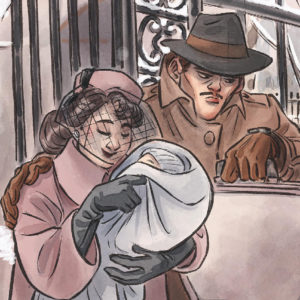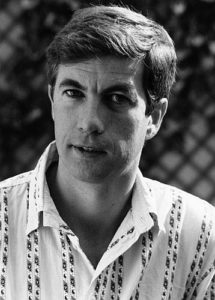 Tramp, the long-running maritime adventure series, began its remarkable voyage back in 1993. The appearance of the latest installment, Storm Warning, and the start of The Aviator, a new series drawn from the Tramp universe, provides a good opportunity to catch up with scriptwriter Jean-Charles Kraehn, co-creator of both series.
Tramp, the long-running maritime adventure series, began its remarkable voyage back in 1993. The appearance of the latest installment, Storm Warning, and the start of The Aviator, a new series drawn from the Tramp universe, provides a good opportunity to catch up with scriptwriter Jean-Charles Kraehn, co-creator of both series.
Five years passed between the original French release of volumes ten and eleven. That’s a long wait!
Yes, and I hope readers weren’t thinking the series was finished! Patrick Jusseaume [co-creator and artist of the series] had some health issues that meant he was unable to finish the volume, which unfortunately delayed its publication.
The title, Storm Warning, has a triple meaning, doesn’t it? The story starts with an actual storm at sea, Captain Yann Calec has to face a “storm” of arms traffickers, and his stormy relationship with Rosanna is once more on the rocks…
Yes, you’re absolutely right! Readers will know straight away that if a storm is brewing, things are not likely to go smoothly for their hero. Even his private life will take a battering. No, we haven’t given him an easy ride this time!
The story centers around arms trafficking, which, as is so often the case in this series, is a theme with contemporary relevance. And then there’s the human trafficking that ensnares Calec later on in the story. Heavy subjects for a comic book!
They’re timeless subjects because they’re linked to human nature, which is diverse and complex, and they’re linked to the constant struggle that is life. It’s the same struggle for those who live on the sea as for those that live on land, even if their way of life puts them in a rather special category. They have the same fears and the same pleasures, but because they spend their whole time traveling, they must face situations that stay-at-home Westerners never encounter. Slavery is as old as humanity itself—or at least has been around for as long as people have had to work for a living. “Traditional” slavery virtually disappeared in the 1950s, except in some Arab countries. But having lived in Mauritania in the sixties, I can tell you that it still existed there, because I saw it. It might not be like it was, but let’s not kid ourselves: it still goes on, just in different ways.
Getting back to Storm Warning, the age-old theme of slave trafficking in the Red Sea also links the story with many adventure novels of the 19th and 20th centuries. There’s a little nod to “The Red Sea Sharks” from The Adventures of Tintin as well. The scene where the dhow [a traditional red sea sailing craft] comes alongside the cargo ship and its captain climbs aboard is a reference to that story, which gripped me as a child.
The character of Moko, the dhow captain, represents a mindset that challenges Calec and the other Westerners. When the two men confront each other, Moko justifies his actions by essentially saying, “What’s good and what’s bad depends on the circumstances.” It’s a scene in which you show that the truth is not always easy to pin down…
What’s true today won’t necessarily be true tomorrow, and what’s true for one culture is even less likely to be true for another. It’s something that we, as supposedly superior Westerners who pride ourselves on our “enlightened” democracy, find hard to understand. It’s a little personal dig at our arrogant tendency to claim that we’re right and to foist our social model onto other peoples, and at our financial imperialism—which is essentially a “soft” form of fascism—and the useful idiots who try to impose its rules on the whole planet, employing democracy as a smokescreen to hide its inequities. All these people slaving away for a pittance and getting moved from place to place “for economic reasons”—in Europe and elsewhere—are they really free and happy? It’s a question that’s worth asking…
When Calec’s daughter is abducted and he has to face the the traffickers’ threats, we feel that you’re really putting your hero in danger. But in fact, he’s never stopped being in danger since the start of the series!
It’s the basic principle of the “adventure” story—a mixture of action and tension. The plot twists and the constant suspense must keep readers on the edge of their seats. At the same time, I always try to incorporate the human element through the relationships between the characters and the way they change psychologically as a result of the challenges they face. This aspect was often ignored in the comics I read as a child, and it’s often ignored in manga and American comics, even today. Beyond that, if I can expose readers to political situations or historical events that they knew nothing about, I’ll be happy. Personally, I love novels or comics that teach me something. At the end of the day, comics are for entertainment and, along with movies, they’re the best way of conveying action stories. But that doesn’t mean they have to be one-dimensional.
Will there be another episode in the series, and will it tell a complete story?
Yes, of course. Whenever possible I like each volume to tell a whole story. Times have changed, and today’s readers don’t always have the patience to wait for the second part of a story.
Tell us about The Aviator, which is another series of yours. The hero, Josef, is in fact a character who first appeared in Tramp and was drawn by Patrick Jusseaume. Is this a case of crossover or is it a completely separate series?
You could say that taking a character from one series and making him the hero of another is a kind of crossover. When Calec meets the pilot Josef (alias “Hard Knock” Tanguy) in Indochina in volume 9, Josef is in his fifties. I’d done a lot of research into the Indochina War—a strange conflict—and I’d read somewhere that flying into and out of Tonkin in those days—between two mountains that were permanently shrouded in mist, without radio navigation—was always like a game of Russian roulette. When you see this guy, who has survived the Second World War, you imagine that he’s been pretty scarred by life. He’s a broken man who has locked himself away in a pointless struggle—a kind of prolonged suicide. We only spend a couple of pages with him in that volume, and I asked Patrick to give him a look that showed the kind of life he’d led. Patrick did this so well that our editor, Philippe Ostermann at Dargaud, called me up one day and said, “Tanguy must have had a fascinating life—why don’t you tell his story?”
Tramp is set in the world of shipping whereas the backdrop to The Aviator is the world of aviation, and yet the two series have a lot in common. What would you say to someone who has been following Tramp to get them interested in reading the new series?
The main thing they have in common is the theme of travel—whether on the sea or in the air. Sea travel has been with us since ancient times, but it still fascinates us as a form of escape, a way of chasing our dreams. For the first fifty years, air travel had a similar fascination, with its amazing technological advances and the daring exploits of the pilots. The sky was literally the limit, and our hero, Josef, was right at the cutting edge of its development.
The other commonality is adventure—commercial as well as personal risk-taking. Planes, like ships, transport passengers and goods, so they connect people both directly and indirectly. There’s the same sense of bravery and comradeship as in any dangerous job that makes one pilot or sailor change course to help another. In both worlds, the relationships between people are based on professional loyalty—to the job, to your colleagues, to your bosses, and ultimately to yourself.
Each episode begins with a prologue and ends with an epilogue, which is a narrative device that allows you to play with time, like flashbacks…
Yes, Calec finds Josef’s diary, which tells the story of his eventful life, so he finds out about it at the same time as the reader. It’s a trick that allowed me to show the key events in the hero’s past, each volume being a complete episode—not only in his life, but also in a specific period of aviation history, such as the development of the Aéropostale service and the Second World War.
Africa during the First World War, then 1920s Paris… each with a very different landscape and planes that were changing all the time. You didn’t make things easy for your illustrators!
No, not at all easy—especially for Chrys Millien, who worked alone on volume 2. The illustrators had to do a lot of research on the different types of aircraft. Not easy, but fascinating! It’s as important for them as it is for me not to lapse into routine. The series starts in East Africa (what is now Tanzania) in 1917, and the idea is for it to end, several episodes later, in 1953 in Indochina. We’ll see…
Translated from an interview that first appeared in the French edition of volume 11 of the Tramp series (Avis de tempête, Dargaud 2017). Header image: Tramp © Patrick Jusseaume & Jean-Charles Kraehn / Dargaud
